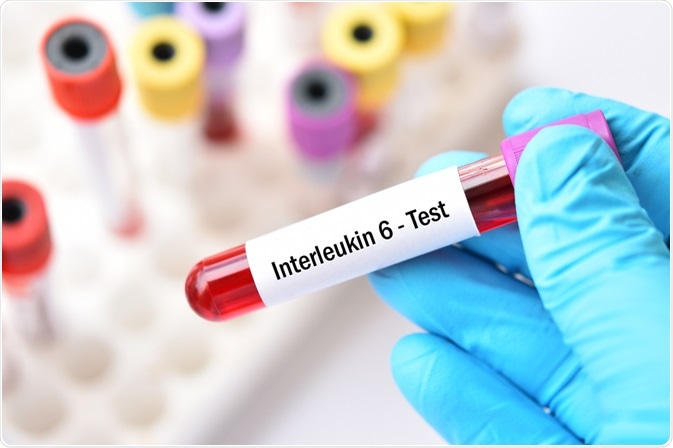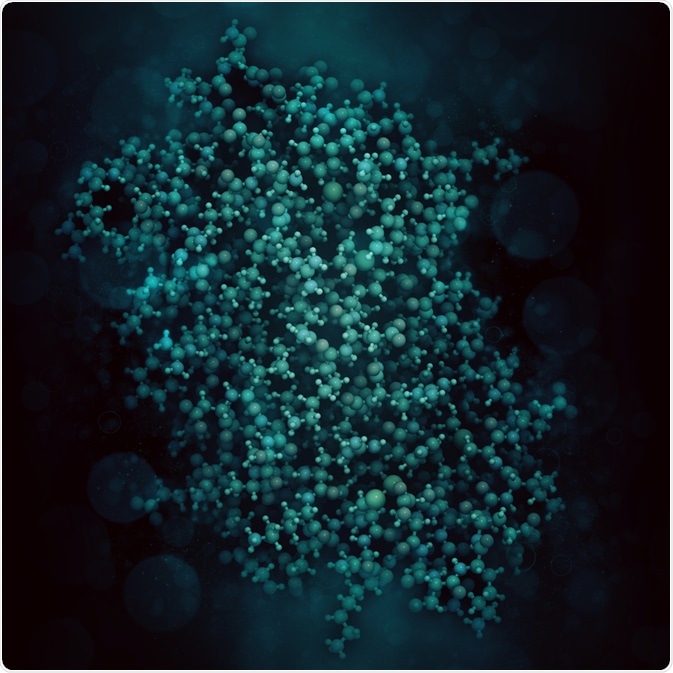Interleukin-6 (IL-6) is a pleiotropic cytokine secreted by T cells and macrophages to activate immune responses during infection or after trauma.
IL-6 plays an important role in a number of bodily processes, including the acute phase response, chronic inflammation, autoimmunity, endothelial cell dysfunction and fibrogenesis.
 Image Credit: Jarun Ontakrai / Shutterstock.com
Image Credit: Jarun Ontakrai / Shutterstock.com
In classical signaling, interleukin-6 exerts its effects by binding to the membrane-bound IL-6 receptor (IL-6R) on target cells. Few cells express this receptor, found on monocytes, B cells (plasma cells), hepatocytes and neutrophils. A subset of T cells also express IL-6R, although research suggests T cells mainly respond to IL-6 via a process called trans-signaling, which begins with IL-6 being bound by the soluble form of IL-6R (sIL-6R).
Endothelial cells do not express IL-6R but are also thought to respond to IL-6 via trans-signaling. In trans-signaling, sIL-6R binds to IL-6 to create an IL-6/sIL-6R complex associated with the gp130 receptor. This activates the STAT3 signaling pathway. This activation of endothelial cells via trans-signaling leads to increased expression of adhesion molecules, chemokine release, and the release of monocyte chemotactic protein (MCP-1) and IL-6.
Interleukin-6 and inflammation
Interleukin-6 has been implicated in the pathology of a number of chronic inflammatory conditions. In the first stage of acute inflammation, proinflammatory cytokines induce the accumulation of neutrophils and the release of IL-6. Chemokines such as IL-8 trigger neutrophils to shed their IL-6Rs, promoting the differential regulation of endothelial cell chemokine production.
This increases the production of MCP-1 and decreases the production of IL-8, which favors the accumulation of monocytes. In addition, IL-6 trans-signalling increases the expression of endothelial leukocyte adhesion molecules, further encouraging the proliferation of leukocytes.
Studies have also shown IL-6 to have an anti-apoptotic effect on T cells, which results in a chronic inflammatory infiltrate. Furthermore, IL-6 trans-signalling induces fibroblasts and endothelial cells to release IL-6 in a positive autocrine feedback mechanism. It is in this way that IL-6 may be key to propagating chronic inflammation.
 Image Credit: StudioMolekkul / Shutterstock.com
Image Credit: StudioMolekkul / Shutterstock.com
Interleukin-6 in autoimmunity
Interleukin-6 is also thought to play a role in autoimmunity. Studies of Crohn’s disease patients suggest that IL-6 trans-signaling via the STAT3 pathway protects autoreactive T cells from apoptosis. IL-6 has been shown to inhibit an enzyme that regulates the internalization of antigens and antigen presentation to T cells, which may lead to the presentation of autoantigens.
Furthermore, one study looked at the role IL-6 plays in models of autoimmune inflammatory arthritis. Using specific antibodies to block classic and IL-6 trans-signaling, the study showed that the classic IL-6 signaling pathway was required to develop pathogenic Th17 cells. These cells are thought to contribute to autoimmunity and the generation of antitype collagen IgG responses linked to disease symptoms in collagen-induced arthritis. In a model of antigen-induced arthritis, the study also showed that IL-6 trans-signalling drove local inflammatory responses.
Immunology - Interleukin 6 (IL6) physiology and IL6 antagonist pharmacology Tocilizumab
Interleukin-6 and fibrogenesis
Interleukin-6 is a profibrogenic cytokine that has been demonstrated to either increase or decrease fibroblasts' proliferation, increase fibroblast collagen, and increase the production of MCP-1 and IL-6. IL-6 controls the expression of vascular endothelial growth factor (VEGF), which is a key mediator of fibrosis and angiogenesis.
Further Reading